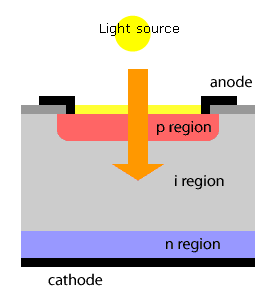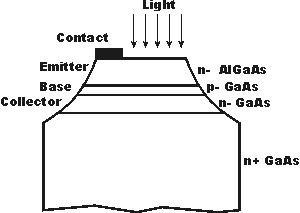Laser Accessories Part 4 (Detectors)
Detectors are device used with lasers to detect or discover the presence of something. There are two categories of the detectors used with laser systems which further splits in their types.
Photoelectric Detectors
The photo electric detectors are sensitive to light. Many types of the photo electric detectors that can be used to measure parameters in laser systems are:
Photodiode, Phototransistor and photovoltaic cell
Photodiode
The photodiode is a PN semiconductor device, which is usually made from silicon. Diagram of typical photo diode along with type package can be drawn as:

In photodiode the P-type material is diffused in an N-type substrate to form the junction. A metal ring over the PN material forms a window that allows the light to strike the diode material. A metal layer forms the base of the diode. This layer along with metal window is areas to which electrical leads are connected.
In lasers the function of photo diode is used to generate the voltage when light strikes the device. This voltage will vary according to the intensity of the incident light. Operation of this type is called photo voltaic mode operation.
On the other hand when photodiode is connected to the voltage source as shown above, then its operation is known as photo conductive mode operation.
The photodiode acts as a variable resistance in electronics circuit as a variable resistance in electronic circuit because it offers the opposition to current flow. This opposition varies with the intensity of light striking the diode surface.
Advantages of photodiodes
- Photodiode offers quick response to changes in light intensity. Therefore it is useful where light intensity changes at rapid rate.
- Photodiode is suitable in instruments that test the laser pulse shape.
- Photodiode is also useful in recording peak powers of laser pulses.
- The response of photodiode changes with the light wavelengths. Therefore photo diode is best suits for use with visible and near infrared wavelengths.
Disadvantages of Photodiode
Due to vary response with light wavelengths photo diode is generally unreliable in the ultra violet range.
Photodiode is easily damaged by light of excessive intensity. Hence instruments using photo diodes are usually subject to only a portion of output energy from the laser and calibrated to indicate actual output values.
Phototransistors
The photo transistor like photodiode is a PN junction device but like ordinary transistor have two junctions and three terminals.
Diagram of typical phototransistor can be drawn as

Like a photodiode, phototransistor has a window that permits light to enter the transistor. Like transistor, photo transistor has three terminals or leads used to electrical hookup, however in some cases phototransistors have only emitter and collector.
In lasers, the phototransistor performs the same function as photo diode means they can generate a voltage when light strikes the surface.
Advantages of Phototransistor
- The phototransistor can deliver much greater current for a given light intensity than photo diodes because of its inherent amplification ability.
- Phototransistor is extremely sensitive device that can be used to obtain accurate reading of very small changes in light intensity.
Disadvantages of Phototransistor
The only disadvantage of photo transistor is that they respond slowly to changes in light intensity, making it unsuitable for applications where fast where fast response time is required.
Photovoltaic Cell
The photovoltaic cell is a device that converts light energy to electrical energy. It generates a voltage across its terminals that vary directly with light intensity.
The cell consists of a PN-junction, a metal ring (holding a transparent window) and a metal base. The metal base and the window ring serve as electrical contacts for the photo voltaic cell.
Photo cells can be made from selenium or silicon etc.
Advantages of Photovoltaic Cell
- Selenium photo cell respond well to wavelengths in the ultra violet and visible region of the spectrum. While
- Photocells made from silicon operate well in the visible and near infrared spectral regions.
Disadvantages of Photovoltaic Cell
- Photo voltaic cell responds relatively slow to change in light intensity.
For this reason, it is best suited for applications where average reading is necessary. For example a photo cell can be used as a detector for a laser power meter.
Thermoelectric Detector
The thermoelectric detectors are sensitive to heat mean’s they are used to measure heat.
In some instances thermo electric detectors produce a voltage while in some instances the resistance of the detector will vary with the amount of applied heat.
Two important thermo electric detectors are Thermocouples and Thermisters.
Thermocouples
A thermo couple is a transducer that produces a voltage in response to a temperature difference. It is made up of two dissimilar metals faced together. When a junction of these metals is heated then thermo couple produces an electrical potential. The polarity and magnitude of the electrical potential depends on the type of metals used.
Some of the metals used with thermo couples are iron, copper, chromel (alloy of nickel and chromium), alumel (alloy of nickel, magnesium, aluminum and silicon) and constantan (alloy of copper and nickel).
Thermo couples in two different forms can be shown as

Clearly one is made from iron and copper. In this case the current flows from iron to copper, when heat is applied. The other is made from alloys chromel and alumel. In this case the current flows from the alumel to chromel. In both cases polarity of the metal is as indicated.
Thermo couple do not produce a high voltage potential. Depending on the materials used some thermo couples may produce as high as 65 milli volts but the average thermo couple produces considerably less.
- The advantage of thermo couple is that they can withstand extremely high temperatures; therefore they are ideal for use with high powered lasers.
- The disadvantage of thermo couple is that their junction must be heated with temperature. So their response time is slow and these types of detectors are useful only for average type reading.
Thermistor
The Thermistor is a solid state device whose resistance decreases when the temperature increases. Thermisters are made from the powered metal oxides that are passed to gather and sintered.
In sintering the metals are heated and welded partially together without actually melting the metals. The sintering process is the most important step in Thermistor manufacturing.
- The advantage of Thermistor is that it is ideal for low temperature sensing. Also it can be used in conjunction with calibrated meter devices to produce an accurate and useful detector circuit.
- The main disadvantage of Thermistor is that they are quickly destroyed by excessive heat.
